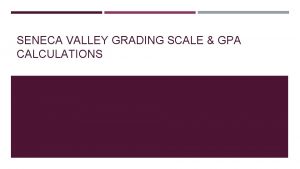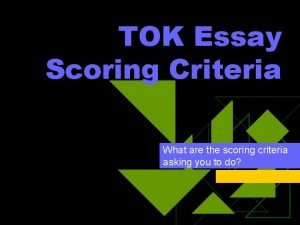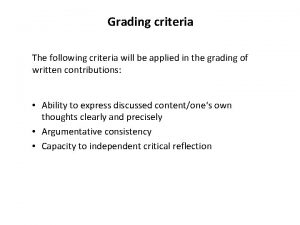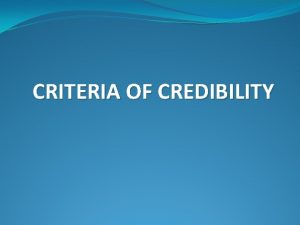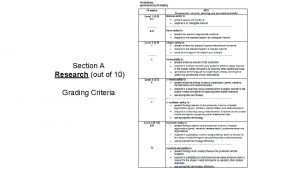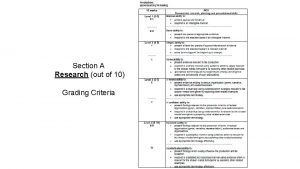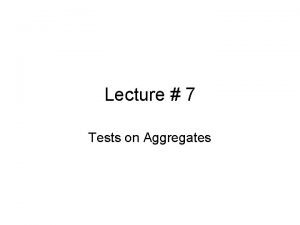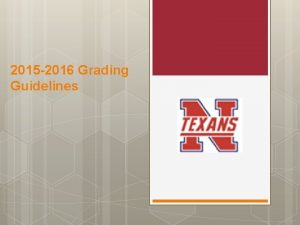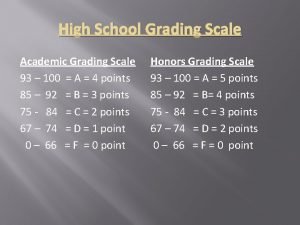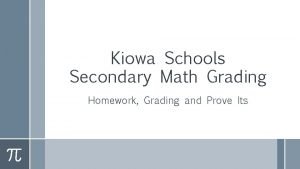SECTION 3 Grading Criteria The Meaning of Grades
















- Slides: 16

SECTION 3 Grading Criteria The Meaning of Grades in education is the process of applying standardized measurements of varying levels of achievement in a course. Grade Definition A An exceptional level of achievement. The student displays a superb command of the subject matter and can creatively apply it at many different levels B A good but not outstanding level of achievement. Students demonstrate a decent grasp of the material and the ability to apply at several but not all levels. C A fair level of achievement. This grade may indicate poor study skills, a lack of motivation or interest, or low ability. Some students get by on their decent test-taking skills. D The student has little or no true understanding of the subject area and may not be motivated or able to learn it. F A performance below the level of random chance. The student lacks interest, motivation, or ability.

Norm-Referenced Grading What is norm-reference Grading? Students are evaluated in relationship to one another. This grading system rests on the assumption that the level of student performance will not vary much from class to class. Advantages • Norm-referenced grading are very easy to use. • They work well in situations requiring rigid differentiation among students where, for example, program size restrictions may limit the number of students advancing to higher level courses. • They are generally appropriate in large courses that do not encourage cooperation among students but generally stress individual achievement. Disadvantages • One objection to norm-referenced grading is that an individual's grade is determined not only by his/her achievements, but also by the achievements of others. • A second objection to norm-referenced grading is that it promotes competition rather than cooperation.

Norm-Referenced Grading: There are multiple ways to curve grades The Bell Curve Normalizes scores using a statistical technique to reshape the distribution into a bell curve. An instructor then assigns a grade (e. g. , C+) to the middle (median) score and determines grade thresholds based on the distance of scores from this reference point.

Norm-Referenced Grading: There are multiple ways to curve grades Clumping The instructor creates a distribution of the scores and identifies clusters of scores separated by breaks in the distribution, then uses these gaps as a threshold for assigning grades.

Norm-Referenced Grading: There are multiple ways to curve grades Quota Systems Often used in law schools, the instructor pre-determines the number of students who can earn each grade. The instructor applies these quotas after rank ordering student scores.

Criterion-Referenced Grading: What is criterion-reference Grading? students are evaluated against an absolute scale. Normally the criteria are a set number of points or a percentage of the total. Advantages • Students are not competing with each other and are thus more likely to actively help each other learn. Disadvantages • It is difficult to set reasonable criteria for the students without a fair amount of teaching experience. • Most experienced faculty set these criteria based on their knowledge of how students usually perform (thus making it fairly similar to the norm referenced system).

The Qualities of a Sound Grading System: A sound grading scheme is accurate, consistent, and valuable to learning. Larger classes require special efforts to ensure these qualities, especially consistency. Accuracy Consistency • A final course grade based on many and varied assignments and tests • Well-constructed quizzes and tests reflecting your student learning outcomes • Point values on tests that reflect the relative importance of the concepts, principles, and relationships • Clear and unambiguous written instructions for tests and assignments • Grading keys and rubrics that, where appropriate, allow the possibility of more than one correct answer • Validity across items, which means discarding an objective test item that practically all the students missed • Grading standards appropriate for the level of your students • Clearly written grading keys and rubrics for assessing responses, particularly if multiple graders are involved • Consensus among multiple graders, which will require discussion of problematic answers • Maintenance of student anonymity to avoid grading biases

Grading Constructed Responses and Papers: Grading answers to constructed response questions requires considerable thought and strategy to ensure accuracy and consistency within reasonable time frames. • Atomistic Grading • Holistic Grading • Analytical Grading

Grading Constructed Responses and Papers: Atomistic Grading This method is content focused and serves well for grading tests and assignments that require only knowledge or low-level comprehension and have one correct response. Advantages • criteria that have fairly clear standards of right and wrong. • Trueness to specified format, organization, quality of data or evidence, logic of reasoning, style and mechanics. Disadvantages • Usually slow (Must attend to details, partial credit and write what is wrong or missing on each paper) • Though objective, students will you challenge anyway. Demand any grade challenges in formal writing with justifications within a tight time limit.

Grading Constructed Responses and Papers: Holistic Grading Advantages • Encourages intuitive expert judgment • Validity • When used with support, student can develop the skill of self judgment Disadvantages of Holistic Grading • Reliability • Needs an expert judge • Transparency

Grading Constructed Responses and Papers: Analytical Grading Advantages • Reliability • Transparency (detailed feedback to students) • Objectivity Disadvantages • Validity: No single correct answer in complex topics • Sum of the parts is not always the whole • Time consuming

Grading Lab Report: Specialized kind of grading for a specialized kind of writing, all guidelines for grading constructed responses still apply. The questions below are also important to take into consideration across all lab reports: • How well does the student understand the problem, and how properly does she address it? • How clearly does she state the hypothesis? • How does she present the results? Does the presentation follow the instructions? Are all the results included? • How clear are the student’s logic and organization? • How strong are her analytical skills in the results and discussion? • How solid is her grasp of the scientific method?

Outcome-Based Grading: • Major learning goals or standards that students will be expected to achieve at each grade level or in each course/unit of study are identified and shared with them. • Evidence or quality standards for each learning goal are identified and shared with students. • A reporting form that communicates teachers’ judgement of students’ learning progress and achievement in relation to learning goals and quality standards has been established.

Returning Student’s Work: • Grade and return tests and assignments as promptly as you can. • Allow class time for review, questions, and problem-solving exercises so students can learn what they did not the first time. • It is best not to proceed to new material until students assure you that they understand what they did wrong.

Helping Students Use Your Feedback to Improve: • Follow up an assignment with another one that makes your students examine and learn from their errors • Should not assume that they will use your feedback to improve their performance next time. • Ask students to write a summary of the feedback contained in your rubric and comments, along with an explanation of how they will use it to improve their next assignment or essay test.

Summary • Assessment focuses on learning, teaching and outcomes, while Evaluation is used for analyzing the assessment data and drawing conclusions. • Formative can be used by instructors to improve their teaching and by students to improve their learning. • Not rely on one type of assessment strategy. A variety of individual and group formative assessment strategies should be used. • Formative method can address different levels of Bloom’s taxonomy.
 Curve grades
Curve grades Seneca gpa grade scale
Seneca gpa grade scale Grading exercise
Grading exercise Tok essay marking criteria
Tok essay marking criteria Difference between sorting and grading
Difference between sorting and grading Hình ảnh bộ gõ cơ thể búng tay
Hình ảnh bộ gõ cơ thể búng tay Frameset trong html5
Frameset trong html5 Bổ thể
Bổ thể Tỉ lệ cơ thể trẻ em
Tỉ lệ cơ thể trẻ em Gấu đi như thế nào
Gấu đi như thế nào Glasgow thang điểm
Glasgow thang điểm Hát lên người ơi
Hát lên người ơi Các môn thể thao bắt đầu bằng tiếng đua
Các môn thể thao bắt đầu bằng tiếng đua Thế nào là hệ số cao nhất
Thế nào là hệ số cao nhất Các châu lục và đại dương trên thế giới
Các châu lục và đại dương trên thế giới Cong thức tính động năng
Cong thức tính động năng Trời xanh đây là của chúng ta thể thơ
Trời xanh đây là của chúng ta thể thơ

